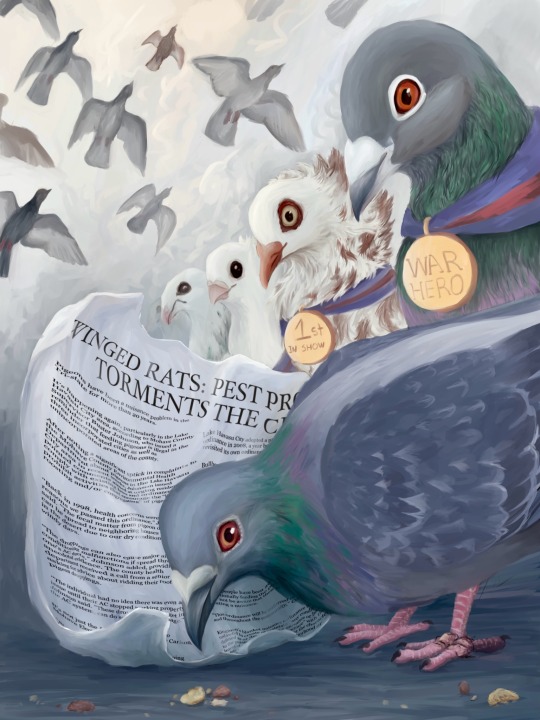#plastic pollution
Text





Made these pieces exploring how birds and people interact last year!
In order of appearance:
Pelican Pollution, Window Strike, Pigeon History, Myths and Culture, Tale of the Honeyguide
#my art#illustration#animal#birds#animal death#plastic pollution#it’s mild but#tw gore#hopefully those tags are sufficient for window strike and pelican polution
2K notes
·
View notes
Text
Plastic producers have known for more than 30 years that recycling is not an economically or technically feasible plastic waste management solution. That has not stopped them from promoting it, according to a new report.
“The companies lied,” said Richard Wiles, president of fossil-fuel accountability advocacy group the Center for Climate Integrity (CCI), which published the report. “It’s time to hold them accountable for the damage they’ve caused.”
Plastic, which is made from oil and gas, is notoriously difficult to recycle. Doing so requires meticulous sorting, since most of the thousands of chemically distinct varieties of plastic cannot be recycled together. That renders an already pricey process even more expensive. Another challenge: the material degrades each time it is reused, meaning it can generally only be reused once or twice.
The industry has known for decades about these existential challenges, but obscured that information in its marketing campaigns, the report shows.
The research draws on previous investigations as well as newly revealed internal documents illustrating the extent of this decades-long campaign.
Industry insiders over the past several decades have variously referred to plastic recycling as “uneconomical”, said it “cannot be considered a permanent solid waste solution”, and said it “cannot go on indefinitely”, the revelations show.
The authors say the evidence demonstrates that oil and petrochemical companies, as well as their trade associations, may have broken laws designed to protect the public from misleading marketing and pollution.
1K notes
·
View notes
Link
It took 90 days for the fungi to degrade 27 per cent of the plastic tested, and about 140 days to completely break it down, after the samples were exposed to ultraviolet rays or heat.
Chemical engineering professor Ali Abbas, who supervised the research team, said the findings were significant.
"It's the highest degradation rate reported in the literature that we know in the world," the professor said.
From ABC News Australia
#plastic#plastic pollution#plastic recycling#trash#environment#hope#good news#technology#science#ecoanxiety#environmental grief#environmental anxiety#ecogrief
3K notes
·
View notes
Text
#good news#nature#science#environmentalism#environment#microplastics#plastic#plastic pollution#plastic pollution solutions
1K notes
·
View notes
Text
1K notes
·
View notes
Text
"Our filter, unlike plastic filters, does not contribute to further pollution as it uses renewable and biodegradable materials: tannic acids from plants, bark, wood and leaves, and wood sawdust—a forestry byproduct that is both widely available and renewable."
"In their research, the team analyzed microparticles shed from widely-used tea bags made of polypropylene. They observed that their technique, termed “bioCap,” captured between 95.2 percent and a staggering 99.9 percent of plastic particles in water, depending on the plastic type. When tested in mouse models, the process was proven to prevent the accumulation of microplastics in the organs"
They said this solution can be scaled up in places like water treatment plants and scaled down for use in the home as well. This is amazing news considering microplastics are one of the biggest problems impacting health these days.
#plastic pollution#microplastics#environmental science#sustainability#good news#water quality#hopefully it doesn't get heavily commercialized and will be easily accessible to all#wrenfea.hope
472 notes
·
View notes
Video
3K notes
·
View notes
Text
The number of kids being diagnosed with autism spectrum disorder ( ASD) and attention deficit hyperactivity disorder ( ADHD) has risen sharply in recent decades, and a new study points to the common plastic additive bisphenol A (BPA) as a potential reason why.
BPA is used in a lot of plastics and plastic production processes, and can also be found inside food and drink cans. However, previous research has also linked it to health issues involving hormone disruption, including breast cancer and infertility.
In this new study, researchers from Rowan University and Rutgers University in the US looked at three groups of children: 66 with autism, 46 with ADHD, and 37 neurotypical kids. In particular, they analyzed the process of glucuronidation, a chemical process the body uses to clear out toxins within the blood through urine.
The research found that kids with ASD and ADHD couldn't clear out BPA and another similar compound called Diethylhexyl Phthalate (DEHP) with as much efficiency as other kids, potentially leading to longer exposure to their toxic effects.
Continue Reading.
312 notes
·
View notes
Link
SYSTEM 002 IN 2022
“We captured our first plastic from the [Great Pacific Garbage Patch] in 2019 with [our ship] System 001/B, and since then we’ve been refining our steering strategy and deepening our understanding of plastic behavior in the oceans.
In 2021 we introduced System 002, and having now demonstrated that our system can consistently harvest significant amounts of plastic, we’re currently in transition to System 03 – our largest and most efficient cleanup system so far.
After demonstrating Proof of Technology the previous year, 2022 was all about cleaning. It was a successful year for The Ocean Cleanup in the GPGP:
System 002: 2022 in numbers
8 trips into the GPGP on cleaning operations
Over 150 days at sea (including transit)
153,000 kg of plastic removed from the GPGP in 2022
4 consecutive trips with catch totals over 25,000 kg
99.9% of catch comprising only plastic
The continuity of cleaning operations during this transition was essential in demonstrating that we are moving towards our efficiency targets and progressing our plan for scale-up. Significant milestones such as the extraction that brought us over the 100,000 kg barrier in the GPGP are documented and shared with our growing community of supporters worldwide, aiding the visibility of our mission and highlighting the urgency of the plastic pollution problem...
PRIORITIZING THE MARINE ENVIRONMENT
We are committed to maximizing our net positive impact on the marine environment. In that light, we place particular importance on one particular figure from our 2022 data: 99.9%. This is the amount of our total catch that consists of plastic, leaving a level of bycatch of 0.1%.
While this is not perfect and we are working hard to reduce it further, we believe this data shows that our mitigation measures and animal protection procedures are working effectively so far. We have also seen a reduction in bycatch rates during the year (see our January 2022 mid-term evaluation) as we implement new learnings and modifications.
Our environmental performance is a result of the measures we have taken since we began our ocean operations. Our systems move very slowly, meaning fish and marine animals can easily swim away, and our crew always has the option of triggering the emergency release to free any animal which has become trapped in the Retention Zone; although this results in the loss of any plastic which has been captured, we keep this option available for any serious encounters.
Upgrades to be implemented during the transition to System 03 include more underwater cameras to allow us to more closely monitor encounters with marine life, and increasing the number of openings throughout the system to allow animals to swim out. We will also be trialing various new deterrent and mitigation measures during 2023, working with our in-house and third-party marine biologists to ensure that we continue to reduce any type of bycatch to the minimal level possible.”
-via The Ocean Cleanup, 12/15/22
#ocean#pacific ocean#great pacific garbage patch#ocean cleanup#pollution#plastic pollution#2022#environment#good news#hope#sorry for all the denseness and jargon#the ocean cleanup is weirdly bad at really basic marketing techniques#like write your articles at a 9th grade-ish reading level#and "have a page dedicated to press about your nonprofit on your website#and I am not in the mood to write a custom post explainer lol
724 notes
·
View notes
Text
pollution from cars is so much more than a combustion engine.
65 notes
·
View notes
Text
Every day, millions of plastic pellets – lentil-sized pieces of microplastic – are pouring into our ocean, spilling from ships transporting them around the world.
You may not realise it, but almost all of the plastic products we use – from water bottles to toothbrushes to fridges – are made from these melted-down pellets or ‘nurdles’.
And though they’re only tiny, they’re causing huge harm to marine wildlife and habitats – smothering seagrass meadows and filling the stomachs of seabirds and seals, fish and turtles, meaning many starve to death.
It’s a scandal that these pellets are being allowed to pollute our ocean, especially when it’s preventable.
The International Maritime Organization (IMO) is the United Nations agency responsible for the safety and security of shipping and the prevention of pollution from ships. It has the power to classify plastic pellets as marine pollutants, which would make them subject to much stricter shipping regulations – immediately.
#people are gonna reblog this just to laugh at the word -nurdles- aren't they#microplastics#plastics#pollution#ocean#plastic pollution#environment
228 notes
·
View notes
Text
Bleached corals ingest microplastics.
Studies have found that reef building corals ingest microplastics when exposed to temperatures above normal.

Normally,corals rely on the photosynthetic algae on their surface to provide them with energy.

When temperatures rise, the algae are expelled (bleaching) and most corals eventually die from starvation but some corals start feeding on zooplankton in the water column and in turn also take in microplastics.
So how is this a problem? Feeding on large amounts of microplastics can result in:
Bleaching
Reduced growth as energy reserves drop since plastic has no nutritive value
Reduced feeding on nutritious prey
Tissue necrosis( a coral disease that causes peeling of tissues and death)
Reduced mineralisation of coral skeletons thus reduced growth rates
With coral reefs already facing multiple stressors ; global climate change, ocean acidification and water pollution with a short period for recovery, microplastics could worsen the situation putting the survival of coral reefs at risk.
#stem academia#conservation#plastic#plastic pollution#plastic waste#sustainability#sustainablelifestyle#ocean#coral sea#coral reef#artificial reef#marine life#animals#marine biology#microplastics#plankton#bleaching#climate change
150 notes
·
View notes
Text
In 2012, Dutch teenager Boyan Slat presented a TED Talk on his concept for cleaning up the ocean with simple mechanisms to sweep up all the trash. While scientists and plastics experts cautioned that his ideas were ineffective, Slat’s non-profit the Ocean Cleanup, founded the year after his talk went viral, has gained millions of followers and big-name backers, including Salesforce, Maersk, KIA, and PayPal’s Peter Thiel. But the venture had one major problem: its first two designs didn’t work, despite the group burning through tens of millions of dollars over the course of a decade. The Ocean Cleanup has since pivoted to work with upstream river “interceptors” that are much more efficient at capturing garbage, but its website still prominently features its latest ocean debris “solution”—essentially a trawl fishing net dragged between two boats that has, to date, collected a comparatively miniscule amount of trash.
Tech projects like these are more of a curse than a blessing. Even if the Ocean Cleanup one day somehow beats the insurmountable odds and removes all surface-level traces of plastic marine pollution, it’d still be missing the vast majority of waste that sinks to the bottom of the ocean floor, or breaks up into tiny microplastics. While companies like these bring increased attention to the plastics crisis, they’re ultimately flashy gimmicks that lull our public consciousness into thinking a clever gadget can solve a collective-action problem. These projects also allow consumer brands—like Coca-Cola, an official “Global Implementation Partner” of Slat’s group—to greenwash their continued massive plastic production, while lobbying behind-the-scenes against regulations that would actually help the world break its plastic addiction.
“We now know that we can’t start to reduce plastic pollution without a reduction of production,” environmental scientists Imari Walker-Franklin and Jenna Jambeck write in the introduction to their forthcoming study, Plastics. To meaningfully address this crisis and others like it, we need to look upstream, invest in reuse infrastructure, and mandate biodegradable packaging and high material recyclability. At a minimum, we need to start making producers bear the cost for the collection and disposal of their poorly designed goods.
219 notes
·
View notes
Link
The Ocean Cleanup, the only organization currently tackling the Great Pacific Garbage Patch (GPGP), has just reached a milestone of 200,000 kilograms, or 220 tons of plastic removed from the ocean.
In recent years, the Dutch non-profit completed the test run of their new system 002/B which can capture multiple tons of garbage in one sequence with its large booms measuring a mile and a half in length
The GPGP is not so much an island as it is an area where major currents and winds have brought together trillions of pieces of plastic.
By using the data of the currents and the winds to estimate volumes of plastic and to guide the capture vessels, Bojan Slat, the CEO and Founder of Ocean Cleanup, believes he can clean the whole patch in just a decade.
From Good News Network
#great pacific garbage patch#pollution#plastic pollution#plastic#ocean restoration#ocean conservation#good news#hope#environment#environmental grief#ecoanxiety#ecogrief
1K notes
·
View notes
Text
#vegan leather#plastic pollution#plastics#pleather#leather alternatives#leather#environmentalism#good news#science#environment#bacteria#microbiology#genetic engineering
144 notes
·
View notes
Text
156 notes
·
View notes